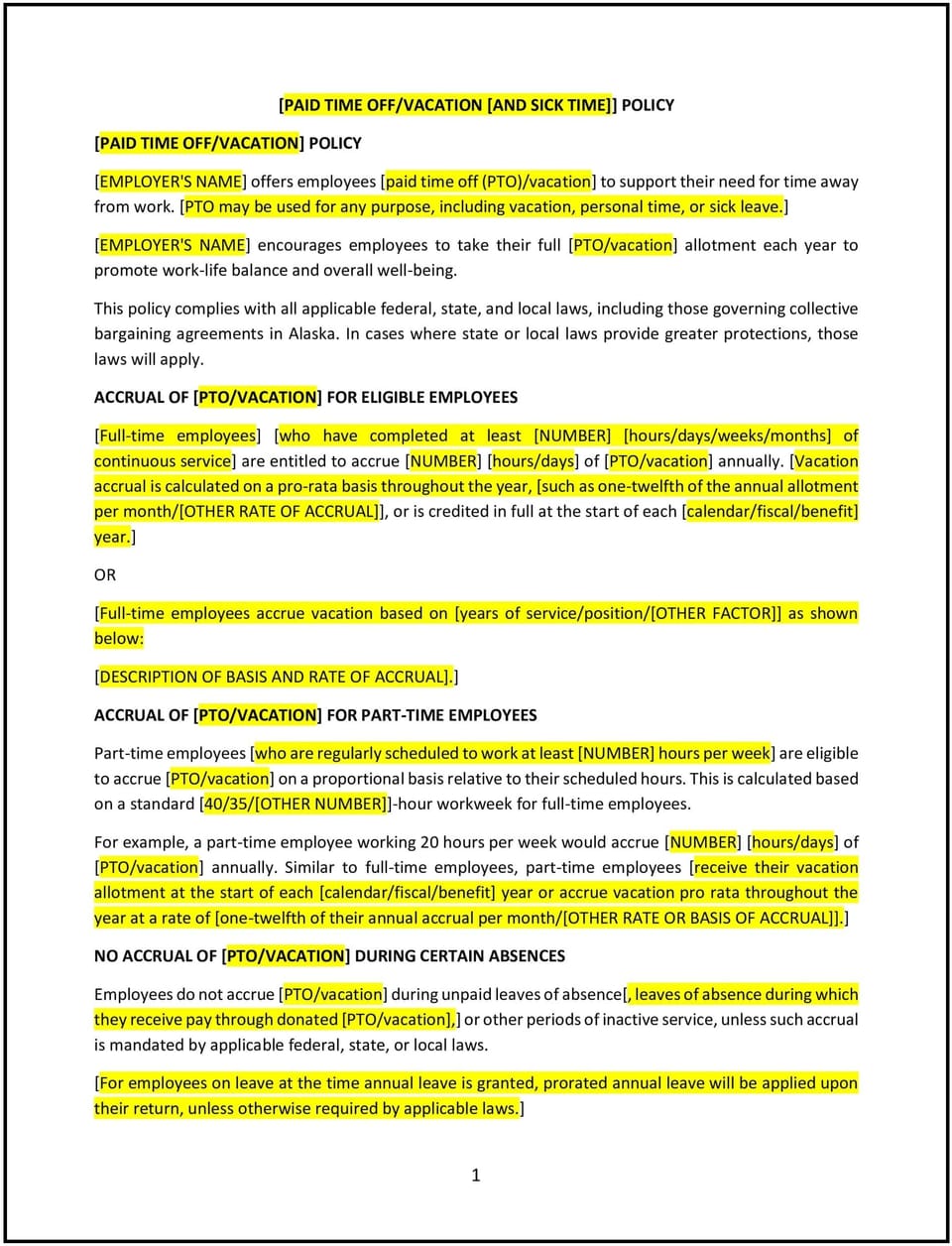Vacation policy (Alaska): Free template

Vacation policy (Alaska)
In Alaska, a vacation policy provides guidelines for employees to request and take paid time off (PTO) for rest, travel, or personal matters. This policy ensures that vacation leave is managed fairly, consistently, and in a way that supports both employee well-being and business operations.
By implementing a vacation policy, businesses can foster a positive workplace culture while maintaining operational efficiency.
How to use this vacation policy (Alaska)
- Define eligibility: Specify which employees are eligible for vacation leave, such as full-time, part-time, or seasonal workers, and outline any waiting periods for new hires.
- Establish accrual rules: Detail how vacation time is earned, such as monthly or annually, and whether unused time can roll over or be paid out.
- Include request procedures: Provide a clear process for requesting vacation leave, including advance notice and manager approval requirements.
- Address scheduling conflicts: Offer guidelines for handling overlapping vacation requests, prioritizing fairness and operational needs.
- Communicate return-to-work expectations: Include any procedures employees should follow upon returning from vacation, such as providing updates or addressing outstanding tasks.
Benefits of using a vacation policy (Alaska)
A vacation policy provides significant advantages for businesses in Alaska. Here’s how it helps:
- Boosts employee well-being: Encourages employees to take time off for rest and rejuvenation, improving morale and productivity.
- Promotes fairness: Establishes consistent rules for vacation accrual and usage, reducing misunderstandings and conflicts.
- Enhances retention: Demonstrates a commitment to work-life balance, making the company more attractive to current and prospective employees.
- Supports operational planning: Helps managers schedule leave in a way that minimizes disruptions to workflows.
- Ensures compliance: Aligns with Alaska labor laws and any applicable federal regulations.
Tips for using a vacation policy (Alaska)
- Tailor to industry needs: Adapt the policy for industries with seasonal or fluctuating demands, such as tourism or fishing.
- Offer flexibility: Where possible, allow employees to use vacation time in smaller increments to accommodate personal needs.
- Encourage use: Promote the use of vacation time to prevent burnout and maintain employee satisfaction.
- Track balances: Use payroll or HR systems to monitor vacation accruals and ensure accurate record-keeping.
- Update regularly: Review and revise the policy to reflect changes in labor laws, company practices, or workforce needs.
Q: How is vacation time accrued under this policy?
A: Vacation time is typically accrued monthly or annually based on the employee’s hours worked, length of service, or employment status.
Q: Can unused vacation time roll over to the next year?
A: This depends on the policy. Some businesses allow rollover, while others may require employees to use their vacation time within a specific period.
Q: How far in advance should employees request vacation leave?
A: Employees should provide notice as early as possible, with a typical minimum of two weeks, to allow for scheduling adjustments.
Q: How are scheduling conflicts resolved for overlapping vacation requests?
A: Managers should consider factors such as seniority, operational needs, and fairness when deciding on conflicting requests.
Q: How often should this policy be reviewed?
A: Review the policy annually or whenever changes occur in labor laws, workforce dynamics, or company operations.
This article contains general legal information and does not contain legal advice. Cobrief is not a law firm or a substitute for an attorney or law firm. The law is complex and changes often. For legal advice, please ask a lawyer.


